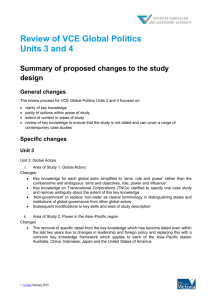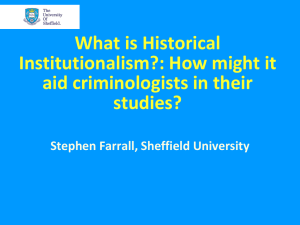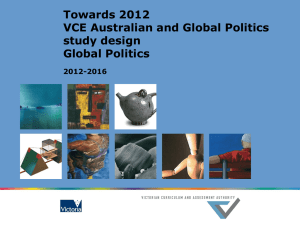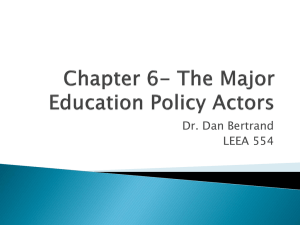Units 3 and 4: Global Politics
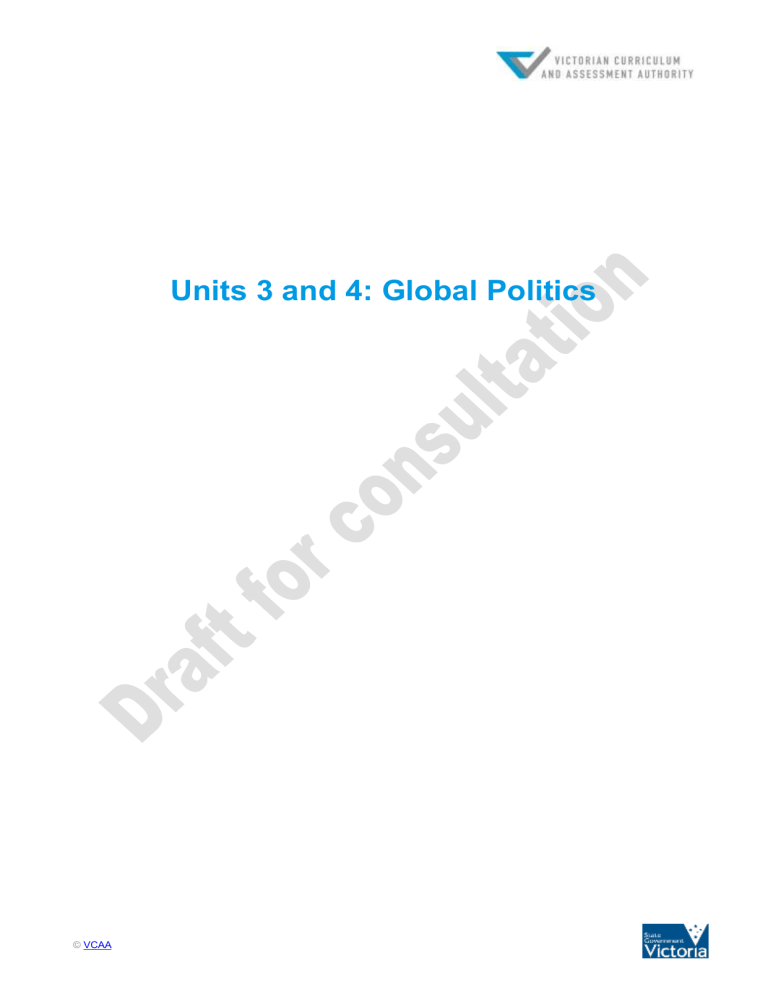
Units 3 and 4: Global Politics
© VCAA
Units 3 and 4: Global Politics DRAFT FOR CONSULTATION
Unit 3: Global actors
In this unit students investigate the key global actors in twenty-first century global politics. They use contemporary evidence to analyse the key global actors and their aims, roles and power. They develop an understanding of the key actors through an in-depth examination of the concepts of national interest and power as they relate to the state, and the way in which one Asia-Pacific state uses power within the region to achieve its objectives.
For the purposes of this study, the term ‘non-government actors’ covers a range of global actors: altruistic non-governments organisations (NGOs), for example Amnesty International and
Greenpeace; organised religions and terrorist movements.
This unit is concerned with contemporary issues and events. While these may have antecedents in issues and events before the twenty-first century that students need to understand to contextualise contemporary global situations, focus needs to be on the twenty-first century when choosing particular examples and case studies.
Area of Study 1
Global actors
Who are the key actors in contemporary global politics? From where does their power stem? What impact do these actors have on global politics? What challenges do these global actors face in achieving their aims?
In this area of study students examine the key actors in contemporary global politics: states, institutions of global governance, transnational corporations (TNCs) and non-government actors.
The state is the principal actor within global politics because the world (with few exceptions) is divided into these political communities; however, its power is challenged. Students consider the challenges to the sovereignty of states. These arise from regional organisations, contested and changing state borders such as secessionist movements and issues and crises which require multilateral action. Such issues have arisen because security is no longer limited to border protection and has expanded to include such things as financial instability, human crises and environmental challenges.
The omnipresent security dilemma faced by states has amplified moves towards global governance. Students come to understand that institutions of global governance are central to cooperative action because they establish, manage and facilitate relations between states through their processes, protocols and legal arrangements.
Students investigate a range of non-government actors, appreciating the growing significance of
‘people power’ and public opinion, which have been facilitated by dramatic changes in communications and technology. Some non-government actors act to challenge the power of the state and prevent it from dominating the rest of society, and pressure it to become more responsive to the needs of its citizens or aid states in meeting their citize ns’ needs. Not all nongovernment actors play a constructive role in the global politics arena as exemplified by global terrorist movements. Students study two non-government actors, such as: human rights organisations, environmental organisations, organised religions and global terrorist movements.
Students consider the role of a TNC within global politics and the global economy. Facilitated by advances in technology and communication, these actors have expanded their role and activities
© VCAA Page 2
Units 3 and 4: Global Politics DRAFT FOR CONSULTATION on a grand scale, affecting most areas of human life. TNCs are considered by some to be predators, exploitative of human rights and the environment, and by others as drivers of progress and innovation.
Outcome 1
On completion of this unit the student should be able to evaluate the power of key global actors in the twenty-first century and assess the extent to which they achieve their aims.
To achieve this outcome the student will draw on key knowledge and key skills outlined in Area of
Study 1.
Key knowledge
the key terms: nation, state, sovereignty, power, global governance, multilateralism, public opinion and globalisation
States
Aims, role and power of states
the challenges facing state sovereignty:
regional groupings
contested and changing borders
issues and crises that require multilateral resolution
Institutions of global governance
Aims, role and power of:
the United Nations
the International Monetary Fund
the World Trade Organization
the International Criminal Court
Non-government actors
• Aims, role and power of two non-government actors from two of the following categories:
human rights organisations
environmental organisations
organised religions
global terrorist movements
Transnational Corporations (TNCs)
Aims, role and power of one transnational corporation.
Key skills
define and explain key global politics terms and use them in the appropriate context
explain the aims and roles of key global actors
evaluate the power of key global actors
analyse the challenges facing state sovereignty
assess the extent to which key global actors achieve their aims
research and synthesise contemporary evidence to draw conclusions.
© VCAA Page 3
Units 3 and 4: Global Politics
Area of Study 2
DRAFT FOR CONSULTATION
Power in the Asia-Pacific region
What is power? Why do different ideas about the national interest exist? How is power exercised by a state in the Asia-Pacific region? What is the most effective type of power for a state to use to pursue its national interest? How effective is the state in achieving its national interests?
In this area of study students examine the way in which a specific Asia-Pacific state uses its power in the region to pursue its national interests, and explore the ideas and debates that form, and have formed, its national interests since 2000.
National interest is an important global politics concept used by states to describe, support and justify foreign policy actions. Students learn that although states vary markedly, they share a common interest in maintaining their sovereignty and national security. They also learn that globalisation and the rise of so-ca lled ‘third-agenda’ issues have elevated the awareness and importance of ‘soft’ national interest security issues, such as the environment, and resource and human security – all of which inform and shape the debate over what constitutes the national intere st. The ‘national interest’ is often contested and views about national interest often depend on factors such as state formation, cultural and ethnic identity, ideology, historical links and relationships to foreign powers.
To achieve its national interest objectives, a state may use a variety of hard and soft types of power and foreign policy instruments. Students consider many different types of instruments available to the state, including diplomacy, trade, aid and use of armed forces. Students develop an understanding that the importance and effectiveness of different types of power and foreign policy instruments in pursuit of a state’s national interests vary considerably, and there is often a marked difference between the intentions and results.
For the purposes of this study, the Asia-Pacific region is comprised of the following:
Pacific Rim states:
Australia, Brunei, Cambodia, Canada, Chile, China, Colombia, Costa Rica, Ecuador, El Salvador,
Guatemala, Honduras, Indonesia, Japan, Malaysia, Mexico, New Zealand, Nicaragua, North
Korea, Panama, Papua New Guinea, Peru, Philippines, Russia, Singapore, South Korea, Taiwan,
Thailand, United States of America, Vietnam.
Pacific Island states and territories:
Fiji, Kiribati, Marshall, Micronesia, Nauru, Palau, Samoa, Solomon Islands, Tonga, Tuvalu,
Vanuatu.
Others:
East Timor, Laos, Myanmar.
Outcome 2
On completion of this unit the student should be able to analyse and evaluate types of power as used by a specific Asia-Pacific state in the region in pursuit of its national interest.
To achieve this outcome the student will draw on key knowledge and key skills outlined in Area of
Study 2.
© VCAA Page 4
Units 3 and 4: Global Politics DRAFT FOR CONSULTATION
For this area of study students will study ONE of the following states in the Asia – Pacific:
Australia
China
Indonesia
Japan
United States of America
Key knowledge
the key terms: sovereignty, national interest, power, nation, state, nation-state, security, idealism, pragmatism
The power used by ONE Asia-Pacific state within the region:
the factors that shape the following elements of national interest:
national security,
economic prosperity,
regional relationships,
global citizenship/international standing
types of power: hard, soft, armed forces economic, political, diplomatic and cultural
the main foreign policy instruments used to try to achieve differing national interests: diplomacy, trade, aid, armed force
the effectiveness of the state in achieving its national interests.
Key skills
define key global politics terms and use them in the appropriate context
use a variety of source material to analyse types of power
analyse ideas and debates about different interpretations of the national interest
evaluate the relative importance and effectiveness of different types of power and foreign policy instruments in the pursuit of the national interest
evaluate the success of a specific Asia-Pacific state in achieving its national interests
research and synthesise contemporary evidence to draw conclusions.
Assessment
The award of satisfactory completion for a unit is based on whether the student has demonstrated the set of outcomes specified for the unit. Teachers should use a variety of learning activities and assessment tasks to provide a range of opportunities for students to demonstrate the key knowledge and key skills in the outcomes.
The area of study and key knowledge and key skills listed for the outcomes should be used for course design and the development of learning activities and assessment tasks.
Assessment of levels of achievement
The student’s level of achievement in Unit 3 will be determined by School-assessed Coursework.
School-assessed Coursework tasks must be a part of the regular teaching and learning program and must not unduly add to the workload associated with that program. They must be completed mainly in class and within a limited timeframe.
Where teachers provide a range of options for the same School-assessment Coursework task, they should ensure that the options are of comparable scope and demand.
© VCAA Page 5
Units 3 and 4: Global Politics DRAFT FOR CONSULTATION
The types and range of forms of School-assessed Coursework for the outcomes are prescribed within the study design. The VCAA publishes Advice for teachers for this study, which includes advice on the design of assessment tasks and the assessment of student work for a level of achievement.
Teachers will provide to the VCAA a numerical score representing an assessment of the student’s level of achievement. The score must be based on the teacher’s assessment of the performance of each student on the tasks set out in the following table.
Contribution to final assessment
School-assessed Coursework for Unit 3 will contribute 25 per cent to the study score.
Outcome 1
Outcomes
Evaluate the power of key global actors in the twenty-first century and assess the extent to which they achieve their aims.
Outcome 2
Analyse and evaluate types of power as used by a specific Asia-Pacific state in the region in pursuit of its national interest.
Marks allocated*
50
50
Assessment tasks
For each outcome select one or more of the following:
• a multimedia presentation
• a case study
• an essay
• a report
• a test
• structured questions
• short-answer questions
• an extended response.
Total marks 100
*School-assessed Coursework for Unit 3 contributes 25 per cent.
External assessment
The level of achievement for Units 3 and 4 is also assessed by an end-or-year examination, which will contribute 50 per cent.
© VCAA Page 6
Units 3 and 4: Global Politics
Unit 4: Global challenges
DRAFT FOR CONSULTATION
In this unit students investigate key global challenges facing the international community in the twenty-first century. They examine and analyse the debates surrounding two ethical issues, which are underpinned by the contested notion of global citizenship. They then evaluate the effectiveness of responses to these issues. Students also explore the context and causes of global crises, and consider the varying effectiveness of responses and challenges to solving them.
This unit is concerned with contemporary issues and events. While these may have antecedents in issues and events before the twenty-first century, that students need to understand to contextualise contemporary global situations, focus needs to be on the twenty-first century when choosing particular examples and case studies.
Area of Study 1
Ethical issues and debates
Do we have a responsibility to uphold the human rights of persons outside our borders? What is the best way to deal with people movement? What does ‘development’ look like? Can the world be rid of weapons, and if so, will it be safer?
In this area of study students examine debates about two global issues. For the purposes of this area of study, two of the following global issues must be examined: human rights, people movement, development, arms control and disarmament. These debates are considered in the context of specific case studies which transcend specific states, regions and continents. Students examine and analyse the effectiveness of the strategies proposed by global actors which may play important roles in both the causes and solutions to the issues.
Students learn that human rights refer to fundamental claims and are restricted as much by what is necessary to secure the comparable rights of others as the right of any particular individual.
However, human rights are continually challenged by those who deny the universality of their application on religious, cultural and economic grounds.
People movement, both internal and external, whether a result of globalisation, conflict, natural disaster, human-made disaster or economic interest, is an issue which states cannot ignore.
Students consider debates about people movement, and consider arguments about moral obligation to help distant foreigners over a state’s national interest, often presented in the form of border security.
Students learn about development issues, global poverty and inequality. They consider debates about the range of solutions presented to alleviate poverty, and the often controversial nature of what constitutes ‘development’, which at times prioritises the acquisition of wealth over political liberties, human rights and the environment.
Arms control and disarmament are both processes by which states seek to construct a more stable and peaceful international arena by reducing the threat posed by other states and non-government actors, such as terrorist groups, to the security of the state. Students explore the ability of arms control and disarmament to achieve a more secure world.
© VCAA Page 7
Units 3 and 4: Global Politics
Outcome 1
DRAFT FOR CONSULTATION
On completion of this unit the student should be able to evaluate two global ethical issues from a range of perspectives and analyse the effectiveness of global actors’ responses to these issues.
To achieve this outcome the student will draw on key knowledge and key skills outlined in Area of
Study 1.
Students will study TWO of the following ethical issues:
Human rights
People movement
Development
Arms control and disarmament
Key knowledge
the key terms: realism, cosmopolitanism, national interest, international society, justice, and ethics
human rights:
international treaties relating to human rights
responses by relevant global actors
ethical debates including: economic and cultural challenges to the universality of human rights, the principle of universality versus religion, justifications for humanitarian and armed intervention including the ‘Responsibility to Protect’
people movement:
international treaties relating to people movement
responses by relevant global actors
ethical debates including: obligations to strangers versus national interest, the rights of refugees versus economic migrants, and strategies for refugee resettlement
development:
international treaties relating to development
responses by relevant global actors
ethical debates including: economic self-determination versus globalisation, overseas development assistance and global targets, development versus sustainable development
arms control and disarmament:
international treaties relating to arms control and disarmament
responses by relevant global actors
ethical debates including: the challenges of state and non-state proliferation, international security vs. state security, arms control versus disarmament.
Key skills
define and explain key global politics terms and use them in the appropriate context
analyse treaties relating to two ethical issues
evaluate ethical debates surrounding two ethical issues
analyse the effectiveness of responses by global actors to selected two ethical issues
research and synthesise contemporary evidence to support arguments.
© VCAA Page 8
Units 3 and 4: Global Politics
Area of Study 2
DRAFT FOR CONSULTATION
Global challenges
What challenges does the world face today? What are the causes of particular global challenges?
How have global actors responded to these challenges and how effective are their responses?
In this area of study students investigate the causes, the effectiveness of responses, and key aspects of two global challenges. Two global challenges are selected from the following: climate change, armed conflict, terrorism, and economic instability.
Climate change presents policymakers with significant difficulties, some of which lie in the fact that responses require global cooperation by states at an unprecedented level. Students consider whether national interests prevail over global climate challenges, and how other economic priorities and political factors play a role.
Students learn that armed conflict remains a common instrument of state power, challenging the idea that it will become obsolete. They consider whether mechanisms of global governance can respond to and stop conflict, and whether the notion of sovereignty presents an insurmountable challenge to responding effectively to conflict.
Terrorism is a salient feature of contemporary global politics. Students come to understand that terrorism is due to the perceived success of such tactics in attracting publicity and the rise of support networks to facilitate terrorist objectives. They consider the effectiveness of terrorism in achieving its aims and consider the reasons why some groups resort to violence to achieve their objectives. Students study in detail key aspects of terrorism including state and non-state terrorism.
Students explore how the increased inter-connectedness of the world economy has brought with it innumerable benefits, but has also amplified the capacity for global economic instability.
Organisations for global economic governance face challenges in coordinating global economic stability, as illustrated by the Global Financial Crisis and the Sovereign Debt Crisis. Students consider whether economic instability is a feature of market economic systems and the increasing interdependence within the global economy.
Outcome 2
On completion of this unit the student should be able to explain two contemporary global challenges and evaluate the effectiveness of responses to these.
To achieve this outcome the student will draw on key knowledge and key skills outlined in Area of
Study 2.
Key knowledge
the key terms: crisis diplomacy, international cooperation, globalisation, unilateralism
TWO of the following challenges:
Climate change:
the causes
the responses and proposed solutions from key global actors
difficulties in achieving effective resolutions
key aspects of climate change, including resource exploitation, national interests, and methods of adapting to and reducing climate change
© VCAA Page 9
Units 3 and 4: Global Politics DRAFT FOR CONSULTATION
Armed conflict:
the causes
the responses and proposed solutions from key global actors
difficulties in achieving effective resolutions
key aspects of armed conflict including intervention, war as an instrument of state policy, prosecuting war and war crimes in international law
Terrorism:
the causes
the responses and proposed solutions from key global actors
difficulties in achieving effective resolutions
key aspects of terrorism including non-state terrorism, terrorism as an instrument of state policy and the role of asymmetric warfare
Economic instability:
the causes
the responses and proposed solutions from key global actors
difficulties in achieving effective resolutions
key aspects of economic instability including globalisation, capitalism’s boom-bust cycle, the role of key global actors as regulators and stabilisers of the global economy.
Key skills
define and explain key global politics terms and use them in the appropriate context
explain the key aspects of two global challenges
analyse causes of and responses to two global challenges
evaluate the effectiveness of proposed solutions and difficulties in achieving effective resolution to two global challenges
research and synthesise contemporary evidence to draw conclusions.
Assessment
The award of satisfactory completion for a unit is based on whether the student has demonstrated the set of outcomes specified for the unit. Teachers should use a variety of learning activities and assessment tasks to provide a range of opportunities for students to demonstrate the key knowledge and key skills in the outcomes.
The area of study and key knowledge and key skills listed for the outcomes should be used for course design and the development of learning activities and assessment tasks.
Assessment of levels of achievement
The student’s level of achievement in Unit 3 will be determined by School-assessed Coursework.
School-assessed Coursework tasks must be a part of the regular teaching and learning program and must not unduly add to the workload associated with that program. They must be completed mainly in class and within a limited timeframe.
Where teachers provide a range of options for the same School-assessment Coursework task, they should ensure that the options are of comparable scope and demand.
The types and range of forms of School-assessed Coursework for the outcomes are prescribed within the study design. The VCAA publishes Advice for teachers for this study, which includes
© VCAA Page 10
Units 3 and 4: Global Politics DRAFT FOR CONSULTATION advice on the design of assessment tasks and the assessment of student work for a level of achievement.
Te achers will provide to the VCAA a numerical score representing an assessment of the student’s level of achievement. The score must be based on the teacher’s assessment of the performance of each student on the tasks set out in the following table.
Contribution to final assessment
School-assessed Coursework for Unit 4 will contribute 25 per cent to the study score.
Outcomes
Outcome 1
Analyse two global ethical issues from a range of perspectives and evaluate the effectiveness of global actors’ responses to these issues.
Marks allocated*
50
Assessment tasks
For each outcome select one or more of the following:
• a multimedia presentation
• a case study
• an essay
• a report
• a test
• structured questions
• short-answer questions
• an extended response.
50
Outcome 2
Explain the characteristics of two contemporary global challenges and evaluate the effectiveness of responses to these.
Total marks 100
*School-assessed Coursework for Unit 4 contributes 25 per cent.
External assessment
The level of achievement for Units 3 ad 4 is also assessed by an end-of-year examination.
Contribution to final assessment
The examination will contribute 50 per cent.
End-of-year examination
Description
The examination will be set by a panel appointed by the VCAA. All the key knowledge and key skills that underpin the outcomes in Units 3 and 4 are examinable.
Conditions
The examination will be completed under the following conditions:
Duration: two hours.
Date: end-of-year, on a date to be published annually by the VCAA.
© VCAA Page 11
Units 3 and 4: Global Politics DRAFT FOR CONSULTATION
VCAA examination rules will apply. Details of these rules are published annually in the VCE and
VCAL Administrative Handbook .
The examination will be marked by assessors appointed by the VCAA.
Further advice
The VCAA publishes specifications for all VCE examinations on the VCAA website. Examination specifications include details about the sections of the examination, their weighting, the question format/s and any other essential information. The specifications are published in the first year of implementation of the revised Units 3 and 4 sequence together with any sample material.
© VCAA Page 12
